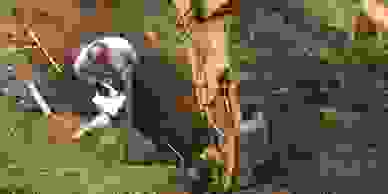Designs

Orcas Sewage Design works with developers, engineers, planners, regulators and builders to create the treatment system needed to meet project-specific requirements. We accommodate sustainable building practices, with low life cycle costs. Our systems are often located in beautiful and environmentally sensitive areas, where effective wastewater systems, that meet or exceed regulatory requirements, are critical. If you’re planning a new home or need a new onsite septic system, septic designer Rick Petro will listen to your needs, personally assess your property and create a unique design that fits your goals.
Design Process
STEP 1: FEASIBILITY
STEP 3: DESIGN & PERMITTING
STEP 1: FEASIBILITY

Have a septic system feasibility study performed on the property to determine the conditions of the ground and what type system the local Health Department is going to require.
STEP 2: REVIEW
STEP 3: DESIGN & PERMITTING
STEP 1: FEASIBILITY
.jpg/:/cr=t:58.97%25,l:0%25,w:100%25,h:37.5%25/rs=w:388,h:194,cg:true/qt=q:1)
Have the local Health Department review the location of the drainfield and soils.
STEP 3: DESIGN & PERMITTING
STEP 3: DESIGN & PERMITTING
STEP 3: DESIGN & PERMITTING

We then prepare the full septic system design and submit it to the local Health Department for their review and approval. Once approved, the design will be valid for five years and can be renewable for additional three years
Design Installation
STEP 1: GET A BID
STEP 2: INSTALL & STARTUP
STEP 2: INSTALL & STARTUP

When you are ready to install, we can help you procure bids from qualified septic installers.
STEP 2: INSTALL & STARTUP
STEP 2: INSTALL & STARTUP
STEP 2: INSTALL & STARTUP

Once system has been installed a “Record Drawing” (an accurate depiction of what is in the ground) will be produced and filed with the local Health Department. Once the system is connected to plumbing of the building and water is flowing, a system startup will be performed to ensure that the system functions as designed.
Different Types of Onsite Sewage Systems
Standard Gravity System
Pressure Distribution System
Pressure Distribution System

Depending on the terrain of your lot and the depths of the soils, you may be able to install an onsite system that discharges effluent to the drainfield via a gravity system. As wastewater flows into the tank at the inlet, it pushes out clear effluent at the outlet. A Bio-tube Effluent Filter on the outlet of your septic tank will protect the drainfield from particles that could clog and damage it.
Pressure Distribution System
Pressure Distribution System
Pressure Distribution System

This system discharges effluent to the drainfield using an effluent pump system. This is necessary when the drainfield is not downhill or soils dictate pressure distribution is required. The effluent pump system is protected by a Bio-tube Effluent Filter and operated by a control panel. The panel may activate the pump based on demand, when the effluent in the tank reaches a certain level. Or it may activate it on a timed schedule. The pump system delivers wastewater to the drainfield in small, uniform doses throughout the day. This keeps the drainfield in a uniformly moist condition favorable to the growth of treatment organisms.
Advanced Treatment Systems
Pressure Distribution System
Advanced Treatment Systems

If your site is unsuitable for a drainfield of conventional size, or if your site has poor soils or is in an environmentally sensitive area, you may need an advanced treatment system. Many of the treatment organisms need oxygen to do their work. In a municipal wastewater treatment plant, and in many, less efficient advanced treatment systems, machinery or blowers continuously aerate the effluent to supply the necessary oxygen.
However, a more stable and energy-efficient practice is to trickle the effluent over a bed of porous material, called a media filter. The filter media develops a thin coating of microorganisms. Nutrients continuously wash over them, and oxygen from the air passively permeates the thin layer of moisture. Periodically trickling effluent with a small pump uses much less electricity than continuously aerating liquid with a blower. Treatment efficiency is also considerably greater, with bio-solids and management significantly reduced. The effluent then goes on to a drainfield.
Copyright © 2020 Orcas Sewage Design - All Rights Reserved.
Powered by GoDaddy Website Builder
